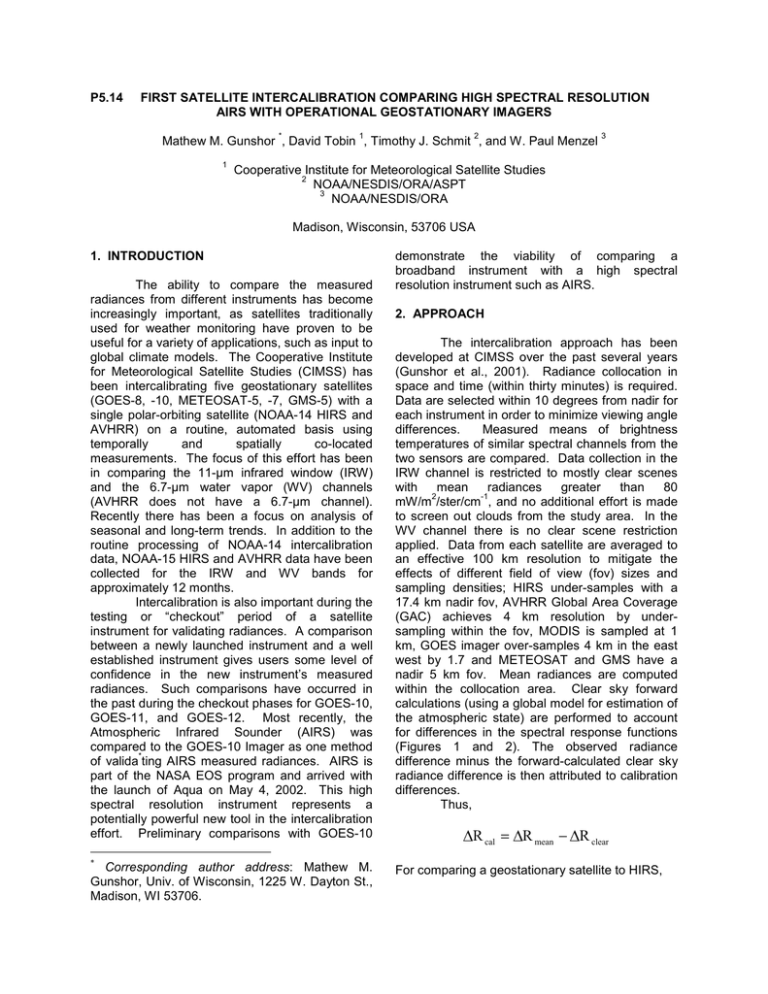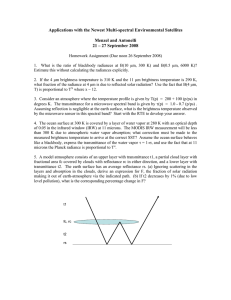P5.14 FIRST SATELLITE INTERCALIBRATION COMPARING HIGH... AIRS WITH OPERATIONAL GEOSTATIONARY IMAGERS
advertisement

P5.14 FIRST SATELLITE INTERCALIBRATION COMPARING HIGH SPECTRAL RESOLUTION AIRS WITH OPERATIONAL GEOSTATIONARY IMAGERS * 1 2 Mathew M. Gunshor , David Tobin , Timothy J. Schmit , and W. Paul Menzel 1 3 Cooperative Institute for Meteorological Satellite Studies 2 NOAA/NESDIS/ORA/ASPT 3 NOAA/NESDIS/ORA Madison, Wisconsin, 53706 USA 1. INTRODUCTION The ability to compare the measured radiances from different instruments has become increasingly important, as satellites traditionally used for weather monitoring have proven to be useful for a variety of applications, such as input to global climate models. The Cooperative Institute for Meteorological Satellite Studies (CIMSS) has been intercalibrating five geostationary satellites (GOES-8, -10, METEOSAT-5, -7, GMS-5) with a single polar-orbiting satellite (NOAA-14 HIRS and AVHRR) on a routine, automated basis using temporally and spatially co-located measurements. The focus of this effort has been in comparing the 11-µm infrared window (IRW) and the 6.7-µm water vapor (WV) channels (AVHRR does not have a 6.7-µm channel). Recently there has been a focus on analysis of seasonal and long-term trends. In addition to the routine processing of NOAA-14 intercalibration data, NOAA-15 HIRS and AVHRR data have been collected for the IRW and WV bands for approximately 12 months. Intercalibration is also important during the testing or “checkout” period of a satellite instrument for validating radiances. A comparison between a newly launched instrument and a well established instrument gives users some level of confidence in the new instrument’s measured radiances. Such comparisons have occurred in the past during the checkout phases for GOES-10, GOES-11, and GOES-12. Most recently, the Atmospheric Infrared Sounder (AIRS) was compared to the GOES-10 Imager as one method * of valida ting AIRS measured radiances. AIRS is part of the NASA EOS program and arrived with the launch of Aqua on May 4, 2002. This high spectral resolution instrument represents a potentially powerful new tool in the intercalibration effort. Preliminary comparisons with GOES-10 * Corresponding author address: Mathew M. Gunshor, Univ. of Wisconsin, 1225 W. Dayton St., Madison, WI 53706. demonstrate the viability of comparing a broadband instrument with a high spectral resolution instrument such as AIRS. 2. APPROACH The intercalibration approach has been developed at CIMSS over the past several years (Gunshor et al., 2001). Radiance collocation in space and time (within thirty minutes) is required. Data are selected within 10 degrees from nadir for each instrument in order to minimize viewing angle differences. Measured means of brightness temperatures of similar spectral channels from the two sensors are compared. Data collection in the IRW channel is restricted to mostly clear scenes with mean radiances greater than 80 2 -1 mW/m /ster/cm , and no additional effort is made to screen out clouds from the study area. In the WV channel there is no clear scene restriction applied. Data from each satellite are averaged to an effective 100 km resolution to mitigate the effects of different field of view (fov) sizes and sampling densities; HIRS under-samples with a 17.4 km nadir fov, AVHRR Global Area Coverage (GAC) achieves 4 km resolution by undersampling within the fov, MODIS is sampled at 1 km, GOES imager over-samples 4 km in the east west by 1.7 and METEOSAT and GMS have a nadir 5 km fov. Mean radiances are computed within the collocation area. Clear sky forward calculations (using a global model for estimation of the atmospheric state) are performed to account for differences in the spectral response functions (Figures 1 and 2). The observed radiance difference minus the forward-calculated clear sky radiance difference is then attributed to calibration differences. Thus, 5 cal = 5 mean − 5 clear For comparing a geostationary satellite to HIRS, GEO HIRS HIRS 5 cal = [R GEO mean − R clear ] − [R mean − R clear ] Where GEO indicates geostationary, HIRS indicates the HIRS instrument, mean indicates the mean measured radiance, and clear indicates the forward calculated clear-sky radiances. Conversion to temperatures for a comparison of a geo to HIRS is accomplished by, GEO GEO HIRS HIRS 7HIRS = [B−1mean − B−1clear ] − [B−1mean − B−1clear ] -1 Where B indicates converting radiance to brightness temperature using the inverse Planck Function. An identical method is used for calculating the temperature difference between a geostationary satellite and AVHRR (∆TAVHRR). This approach is identical for HIRS and AVHRR comparison to all geos using NOAA-14 and -15. For comparing AIRS to a broadband geo such as GOES-10, the high spectral resolution AIRS data is convolved with the GOES spectral response function and then compared to GOES. This works well in areas of the infrared spectrum where AIRS coverage includes all of the GOES spectral bandwidth (Figure 3). However, in the water vapor region AIRS does not cover some of the GOES bandwidth and methods for improving the comparison are currently under study. The method varies slightly from what is described above for comparison of two broadband instruments in that there is no correction for spectral response differences, since theoretically the convolution negates that need. Figure 1. Infrared Window Channel spectral response functions with a high spectral resolution earth emitted spectrum from a High-resolution Interferometer Sounder. Figure 2. Water Vapor Channel spectral response functions with a high spectral resolution earth emitted spectrum from a High-resolution Interferometer Sounder Figure 3. AIRS spectra with GOES-10 Imager spectral response functions (bands 2, 3 4, and 5 from right to left). Notice, there are gaps in the spectra under GOES Imager band 3 (the WV). 3. RESULTS Intercalibration results for the five operational geostationary satellites compared with NOAA-14 and -15 are shown in Tables 1 and 2. The mean is the average of all cases for the indicated satellite and a negative sign indicates the measurements, after correction for spectral response differences, from the polar-orbiting instrument (HIRS or AVHRR) are warmer than those from the geostationary instrument. In general, all five geostationary instruments are measuring colder mean corrected temperatures than HIRS and AVHRR in the IRW channel; they measure warmer corrected temperatures on average than HIRS in the WV channel. The standard deviation is the deviation about the mean. In the IRW channel the standard deviations for ∆TAVHRR are lower than they are for ∆THIRS; the standard deviations for the WV channel comparisons are larger than those in the IRW channel for ∆THIRS for NOAA-15, but this is not always true for those comparisons for NOAA-14. Due to Meteosat-7’s schedule there are no WV comparisons between NOAA-15 and Meteosat-7 since the temporal requirement (within 30 minutes) is never met. In preliminary data sets on June 14 and July 4, 2002 AIRS compared very favorably to GOES-10. After correcting for convolution errors AIRS was less than 0.1K colder than GOES-10 for 3.9-µm (band 2), 1.0K colder at 6.7-µm (band 3), 0.2K colder at 11.0-µm (band 4), and 0.3K colder at 12.0-µm (band 5). The estimated convolution error is only large for band 3, where it is approximately 2.6K, compared with less than 0.1K in all other bands. This is due to the small gaps in the AIRS spectra covering the GOES bandwidth in the water vapor absorption region (Figure 3). Table 1. January 2000 through July 2002 IRW (top) and WV (bottom) comparison of geostationary satellites and NOAA-14 HIRS and AVHRR. N-14 Delta (geo – leo) Number of Comparisons Mean Standard Deviation ∆THIRS ∆TAVHRR ∆THIRS ∆TAVHRR ∆THIRS ∆TAVHRR N-14 Delta (geo – leo) GOES-8 IRW 42 42 -0.6 K -0.3 K 0.8 K 0.3 K GOES-10 IRW 353 353 -0.6 K -0.1 K 1.2 K 0.3 K MET-5 IRW 352 352 -0.8 K -0.4 K 1.1 K 0.6 K MET-7 IRW 424 424 -1.1 K -0.7 K 1.1 K 0.7 K GMS-5 IRW 137 137 -0.9 K -0.6 K 1.0 K 0.6 K GOES-8 WV GOES-10 WV MET-5 WV MET-7 WV GMS-5 WV Number of Comparisons ∆THIRS 237 488 458 327 252 Mean ∆THIRS 1.5 K 2.2 K 3.9 K 3.9 K 1.2 K Standard Deviation ∆THIRS 0.7 K 0.8 K 1.3 K 0.8 K 1.0 K Table 2. September 2001 through August 2002 IRW (top) and WV (bottom) comparison of geostationary satellites and NOAA-15 HIRS and AVHRR. N-15 Delta (geo – leo) Number of Comparisons Mean Standard Deviation ∆THIRS ∆TAVHRR ∆THIRS ∆TAVHRR ∆THIRS ∆TAVHRR N-15 Delta (geo – leo) GOES-8 IRW 39 39 -0.1 K 0.1 K 0.9 K 0.4 K GOES-10 IRW 168 168 -0.1 K -0.2 K 1.4 K 0.4 K MET-5 IRW 175 175 -0.5 K -0.6 K 1.8 K 1.4 K MET-7 IRW 198 198 -1.2 K -1.0 K 1.1 K 0.7 K GMS-5 IRW 40 40 -0.6 K -0.7 K 1.3 K 0.4 K GOES-8 WV GOES-10 WV MET-5 WV MET-7 WV GMS-5 WV Number of Comparisons ∆THIRS 119 219 200 0 78 Mean ∆THIRS 0.6 K 1.8 K 3.2 K na -0.1 K Standard Deviation ∆THIRS 1.1 K 1.5 K 1.8 K na 1.7 K 4. SEARCHING FOR SEASONAL TRENDS The data were divided into four seasons as a first approximation. Winter covers December 22 through March 20; spring covers March 21 through June 21; summer covers June 22 through September 21; fall covers September 22 through December 21. Mean temperature differences for each season do not reveal an obvious seasonal dependence. As an example, seasonal means of temperature differences for NOAA-14 AVHRR are shown in Figure 4. While there are differences for any given leo from one season to the next in Figure 4, there are no consistent trends from one geo to the next. In addition, the variations from season to season are relatively small, in all cases smaller than the standard deviation over the entire time period. Cursory examination of time series plots also does not reveal any obvious seasonal dependence of temperature differences. Figure 5 shows a time series plot of GOES-10/NOAA-14 AVHRR temperature differences (∆TAVHRR) for the IRW as an example. There are almost no points for the last 2 months of 2001 because NOAA-14 AVHRR had a scan motor problem and data was unusable for most of that period. There are several analysis techniques shown in Figure 5. The dotted line is the mean temperature difference (∆TAVHRR) for the entire time period. The dashed line is a cumulative mean, the mean of all values in the time series from the beginning. The solid, bold line is an interpolated running average. Data are interpolated to a temporal resolution of one calculation per day and then averaged with a 21 day running filter. Any point on the solid line is the average of the 10 interpolated values before and after, including said point. This illustrates a smoother curve where possible seasonal dependencies may be seen as opposed to the scattered nature of the actual calculations. While there does not appear to be a seasonal dependence in this plot, there may be other patterns that are not as easily explained. For instance, a comparison of the GOES-10 / NOAA14 (∆THIRS) plots in the IRW and WV channels reveals some similarity in the interpolated running average where peaks and valleys appear in the time series (not shown). This may indicate that there are some patterns present, but perhaps not easily distinguishable from the noise, and not associated with a seasonal trend in the traditional sense. Figure 4. Seasonal mean temperature differences for NOAA-14 AVHRR (∆TA) in the IRW from January 2000 through July 2002. Figure 5. Temperature difference time series for GOES-10 and NOAA-14 AVHRR (∆TA) in the IRW from January 2000 through July 2002. 5. CONCLUSIONS 7. REFERENCES Using a polar orbiter as a reference, the five geostationary satellites compare favorably in the infrared window channel, within nearly 1K with few exceptions. In the largest data set, the geos are within 0.5K (HIRS) and 0.6K (AVHRR) for NOAA-14. Comparisons in the WV band show more variability; using only HIRS they compare to within 2.7K using NOAA-14 and 3.3K using NOAA-15. GOES-8, -10 and GMS-5 form one group that compare favorably to each other in the WV and METEOSAT-5 and –7 form another. METEOSAT-7 is used to calibrate METEOSAT-5, so a favorable comparison is not unexpected and reflects upon a successful use of vicarious calibration methods. However, the differences in the WV comparisons between GOES / GMS and METEOSAT are difficult to explain. A partial explanation may be attributed to the broader water vapor bandwidth of METEOSAT (see Figure 2) and the difficulty in calculating atmospheric water vapor transmittance. Other causes may be a higher degree of uncertainty in the calibration of the WV channel for some instruments and the greater inhomogeneity of the atmospheric water vapor structure. The seasonal analysis did not reveal any seasonal trends in calibration based on the traditional four seasons. This does not eliminate the possibility that there could be other timedependent trends in calibration accuracy. It is not possible, from this study, to determine which satellite is the most accurately calibrated. It is only possible to compare them to each other. It may be possible to use AIRS as a “truth” measurement and get a more accurate assessment of the absolute calibration of geostationary instruments. Through the use of convolution with the spectral response functions of another instrument, AIRS can approximate the measured signal of any band on any broadband instrument covering the same part of the IR spectrum. The accuracy of this method depends in large part on the accuracy of the spectral response function of the broadband instrument. Gunshor, M. M., T. J. Schmit, and W. P. Menzel, 2001:Intercalibration of geostationary and polar-orbiting infrared window and water th vapor radiances. Report of the 11 Conference on Satellite Meteorology and Oceanography, held 15 – 18 October 2001 in Madison, Wisconsin, USA. AMS Publication. Menzel, W. P. and J. F. W. Purdom, 1994: Introducing GOES-I: The first of a new generation of geostationary operation environmental satellites. Bull. Amer. Meteor. Soc., 75, 757-781. 6. FUTURE WORK As data becomes more readily available from AIRS comparisons will be done with all geostationary instruments. New instruments such as NOAA-16, NOAA-17, and MSG will also be included in future analyses.





